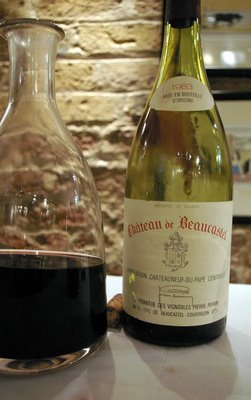King of the (Beau)castel
No wine region in France’s southern Rhône is more recognized than Châteauneuf-du-Pape. The history of the appellation dates back to the fourteenth century when Pope Jean XXII chose Châteauneuf as the location for his summer residence (Rome is nice, he must have thought, but Nice is nicer — well, close to Nice anyway) and proceeded to have some vines planted there. And in 1929, the the fifty-five vineyards surrounding the Pope’s “new castle” were granted the appellation of Châteauneuf-du-Pape.
 Of the great estates of the region, Château de Beaucastel is perhaps the most famous. Its reputation for producing ageworthy and complex wine was further enhanced when the prestigious British wine magazine Decanter awarded the 1990 Château de Beaucastel “Wine of the Year” status a few years ago.
Of the great estates of the region, Château de Beaucastel is perhaps the most famous. Its reputation for producing ageworthy and complex wine was further enhanced when the prestigious British wine magazine Decanter awarded the 1990 Château de Beaucastel “Wine of the Year” status a few years ago.
The history of this particular château dates back to 1549 when the Beaucastel family acquired a barn in a place called Coudelet. A series of owners oversaw the growing property until 1909, when it passed into the hands of Pierre Perrin. Today, the estate remains with the Perrin family, who has also extended its reach into other areas of the south Rhône.
A number of factors combine to give the Château de Beaucastel its unique flavour profile. The stony, porous soil results in good air circulation as well as poor water retention, which forces the vines to dig deep for nutrients. The surface layer is composed of galets — fist-sized rounded stones that absorb heat during the day and transmit it back to the vines at night.
All thirteen of the authorized grape varieties for the appellation are grown in Beaucastel’s seventy hectares of vineyard, though the typical Beaucastel blend is largely Mourvèdre, Grenache and Syrah. In addition, though it isn’t indicated anywhere on the label (and the Perrins don’t play up the fact), Beaucastel is an organically grown wine. Since 1964, no chemical fertilizers, pesticides or fungicides are used in the vineyard. Bees, ladybugs and worms do the work naturally and weeds are removed by plough or by hand.
François Perrin, Global Export Manager for the Perrin line of wines, passed through Toronto this past spring to lead a handful of media types through a (much appreciated) vertical tasting of Château de Beaucastel that included the 2003, 1998, 1995, 1990, 1989 and 1981 as well as the 2003 Châteauneuf-du-Pape “Les Sinards” (made from younger vines than Beaucastel). The knockouts were the 1990 and 1981 (both, unfortunately, unavailable), but each vintage displayed the power, elegance and age-worthiness that have made Château de Beaucastel so famous. From the sounds of it, the 2004 and 2005 vintages will be worth the lineup.
Châteauneuf-du-Pape “Les Sinards” 2003
Made from younger vines than Beaucastel and from 70 per cent Grenache, “Les Sinards” offers up a nose of black cherry, red licorice and mild spice. On the palate, it showed spicy, ripe, bright cherry fruit wrapped in a medium-bodied package with a moderately long, spicy finish.
Château de Beaucastel 2003
Aromas of deep plum, cherry, leather and smoke characterize this one. A tad closed at this point, it nevertheless displayed good depth with some peppery black fruit flavours.
Château de Beaucastel 1998
The 1998 shows a complex, funky, earthy, barnyard and blackberry aroma with the telltale sign of “bret” (brettanomyis). Very well structured and powerful with layers of rich, warm, peppery fruit capped off by a long, memorable finish, the 1998 shows terrific ageing potential.
Château de Beaucastel 1995
Similar aromatically to the 1998, the 1995 displays an additional herbal element on the nose. Still somewhat tight in the mouth with a bit less body than the 1998, it does show some intriguing mineral nuances with traces of black olive and anise.
Château de Beaucastel 1990
In a word: wow! While the nose shows characteristics of the 1995 and the 1998, the flavours of the 1990 are stunningly complex — with tons of cedar, blackcurrant, leather and black pepper capped off by a beautifully long, moderately spicy finish. A very impressive example, indeed.
Château de Beaucastel 1989
Kirsch, cassis, earth, smoke and exotic spices on the nose; chocolate, smoked meat, coffee, black cherry and bramble notes on the palate; the 1989 displays power, richness and excellent length. A fine showing from a very respected vintage.
Château de Beaucastel 1981
Another classic Beaucastel with a beguiling nose hinting at coffee, plum, sandalwood, wild mushroom and leather. Beautifully complex and elegant with incredible structure and a long, intense finish, this is a delicious bottle that aptly demonstrates the tremendous ageing potential of Château de Beaucastel.
